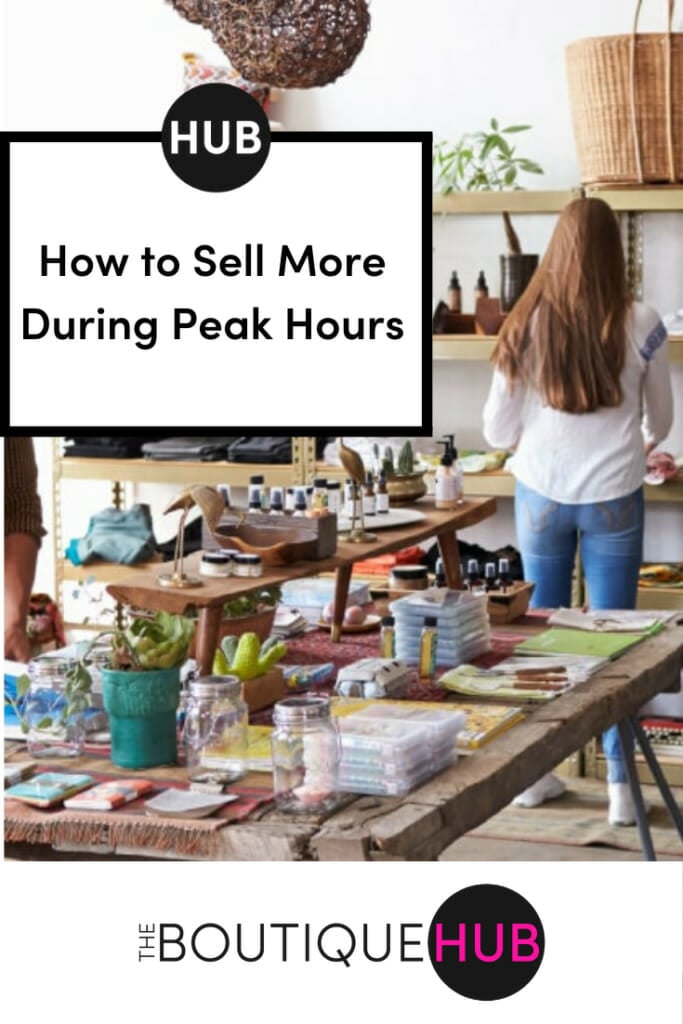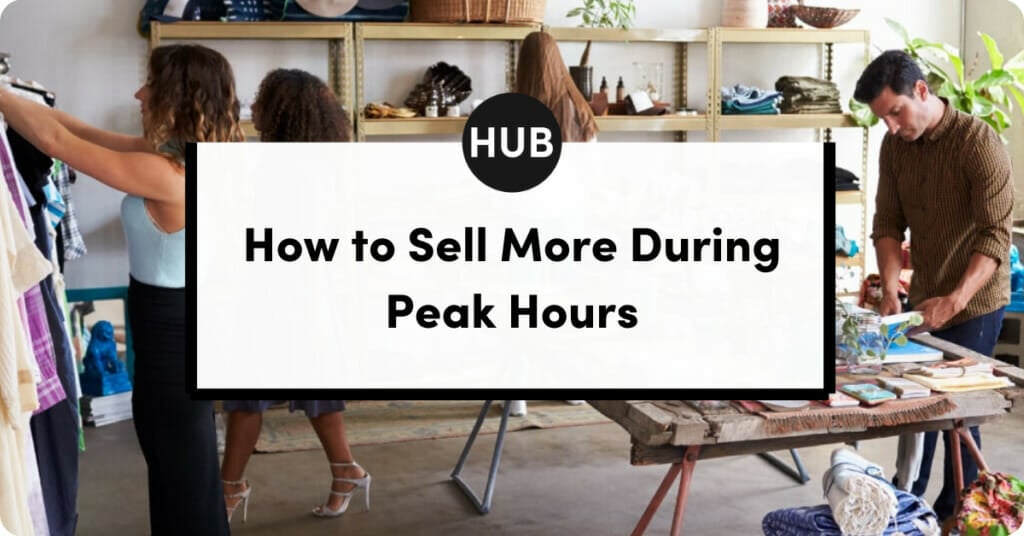Most retailers share the goal of driving more in-store foot traffic, but what good are more customers if you aren’t selling more during peak hours?
Whether it’s through cross-selling and upselling, promotions or just flat-out amazing customer service—learning how to sell more during peak hours is a must for any retailer that wants to grow.
<Guest Blog Post>
In this post, let’s focus on how you can do just that. We break it down into five retail sales tips:
- Find your store’s peak hours
- Schedule your top sales associates
- Provide effective sales training
- Offer complimentary and paid services
- Launch attention-getting promotions
- Speed up the buying process

Let’s dive in!
1. Find your store’s peak hours
The first thing you need to know to sell more during peak business hours is to actually know when your peak hours are. Start by evaluating the volume of people in your store and when they’re most likely to purchase.
You can find that out using your point of sale system’s sales and employee reports; with Lightspeed, we suggest pulling the Sales by Hour of Day report for a clear view of the percentage of total sales each hour of the day accounts for.
In the above example, we can see that peak sales are between 11 a.m. and 4:00 p.m. on Sunday.
But keep in mind that peak in-store traffic might not align with your best selling hours. If customers are just browsing, your point of sale systems sales reports can’t capture that information.
If you’re curious about your non-transactional store traffic, we’re a big fan of RetailNext, a people counter solution that measures walk-in customers, average visit durations and store flow patterns, and pushes those numbers in real-time to your point of sale system.
It’s also a good idea to compare your online sales versus your in-store sales by day of the week. Are there days of the week where online sales or site traffic spikes?
Perhaps you can run a promotion that’s exclusive for in-store customers (or offer free in-store pickup), advertise it on your site and convert more online traffic into in-store sales.
To do just that, we like using Lightspeed’s eCom Sales by Day of the Week report. By knowing when your online store is most active, you can explore running dayparting campaigns, timing your in-store promotions better and converting that traffic into sales.
2. Schedule your top sales associates
Now that you know when your peak hours are, you can schedule your A-Team of sales associates to get the most of that traffic.
Hopefully, your sales team is strong across the board, but even so, you’ll have top performers who really stand out.
Take a look at your employee reports and pinpoint the sales associates with the highest total sales and items per transaction in relation to their hours worked. If possible, we also suggest checking their customer reviews through a post-purchase NPS survey.
Editor’s note: Lightspeed Analytics’ Individual Performance and Upsells employee reports can help you track this. This can tell you a great deal about which team members you want to call in during those busy periods.
You want to identify the sales associates who are most effective at closing sales and put them on the schedule during peak hours because they’re the ones who can close generate the most revenue.
In many cases, these sales associates have the most experience and have a great deal of knowledge about your brand, services and products. They’ll be able to help the customers effectively and offer relevant recommendations with a smile.
We suggest scheduling at least one of your top-performers at all times when you’re expecting high volumes of traffic.
3. Provide effective sales training
Ideally, all of your sales associates can hold their own on the sales floor, especially when it comes to effectively cross-selling and upselling products and services.
Cross-selling allows you to encourage “add-on” items to purchase, such as getting users who are buying an engagement ring to buy the matching wedding band with it.
Upselling is the practice of getting users to purchase a product that’s a higher value than the one they were originally looking at. Instead of that $1,000 engagement ring they’re considering, you also want to show them the $1,500 counterpart and explain why it’s superior, as long as you think it’s within their budget.
Both cross-selling and upselling can significantly increase average transaction value (ATV) and maximize revenue. Make sure your sales associates have enough product knowledge to be able to suggest alternative and additional purchases that are relevant to the customer’s wants and needs.
You can read about cross-selling and upselling in-depth here, but a few simple tips to teach your sales associates can include:
- Recommending complementary products to the one that customer is purchasing, framing it as a package, bundle deal or “perfect set.” If they’re buying a phone, suggest car chargers and phone cases, too.
- Put the emphasis on the features. When upselling, search for needs customers may have that could be solved with the higher-value product. A newer version of the phone, for example, may have superior camera and call-recording features that a journalist or reporter could benefit extensively from.
- Ask about what else the customer may need and suggest products. “Is there anyone else you wanted to shop for?” is a great question to ask, actively putting the task of coming up with additional purchases on the customer’s mind.
When it comes to online selling, there are a ton of eCommerce plugins to choose from. For Lightspeed eCom users, our personal favorites are MyAbandonedCart and MyProductUpsell.
MyAbandonedCart helps retailers reduce the number of abandoned carts by sending that customer an email reminder. Recovering abandoned shopping carts is a must-have for anyone selling online.
MyProductUpsell lets you suggest similar products to the one a customer adds to their cart. Whenever they add an item to their cart, they see the other similar and related products you offer at different price points. This makes it easier for a customer to browse your product offering and increases the likelihood that they add more items to their cart or purchase a higher value item.
4. Offer complimentary and paid services
Complementary services can not only encourage people to visit your store, but they can also encourage additional purchases.
For fashion and apparel retailers, tailoring is a great example of a complimentary service that can drive more sales.
If a pair of pants doesn’t fit exactly how a customer wants, you can close the sale by offering to tailor the garment exactly to their liking. Moreover, you can invite the customer to tailor other garments at your store. This not only helps you close a sale, but increases that customer’s lifetime value with repeat purchases.
5. Launch attention-getting promotions
A solid in-store promo can help your sales associates close more sales. We suggest focusing your in-store promotional efforts on point of sale marketing and time-sensitive promotions.
Optimize in-store promotional materials
Did you know that your store layout has an effect on sales?
Placing low-cost “add-ons” near your cash register can incentivize last-minute impulse purchases. We call this point of sale marketing.
You’ll also want to have in-store promotional materials that can help your team with some of the selling, too.
Signs that use FOMO-driven language leverage scarcity and urgency to remind users to take advantage of a limited-time offer can incentivize people to purchasing more or different products.
Create time-sensitive in-store promotions
Online shopping has increased significantly in recent years, partially thanks to the sheer convenience of it. As a result, it’s not uncommon to have people come in your store to browse, but who may not have a ton of motivation to purchase.
You can drive more high-intent traffic into your store by promoting time-sensitive in-store promotions online.
Bring customers into your physical store with flash sales, great deals on in-stock clearance items, and even offers like free gifts like a makeup pallet with a purchase over a certain value. You can then have your well-trained, high-performing staff leverage upselling and cross-selling, increasing their purchases overall.
Time-sensitive can be key here because you want to drive purchases now; if people feel like a great deal will run out fast, they’ll be much more likely to purchase right away instead of wanting to think it over.
6. Speed up the buying process
When I worked in retail, peak sales hours were chaotic, with sales associates waiting in line to check out their customers, and customers lined up halfway through the store. It wasn’t uncommon to see customers walk in, decide it was too busy, and walk back out, even if they would have likely purchased otherwise.
Setting up a mobile POS system is something that all retail stores should be doing. Each of your sales staff can have their own tablet that they can use to quickly process sales and complete transactions. They can do this anywhere in the store, without having to be at the cash register. That streamlines and improves the experience for both your team and your customers alike.
An Irisys study found that the average American consumer will leave a store without making a purchase after waiting eight minutes. Retailers simply can’t afford to make customers wait, since it’s more than likely to impact their sales.
You want customers to be able to purchase the second they’re ready to do so, as it eliminates the risk of someone walking due to a long wait time. And don’t forget that the faster your team is able to complete one transaction, the sooner they can serve another customer and make more sales!
Ring up sales from anywhere
With Lightspeed’s cloud-based POS, you can eliminate customer wait times, all while offering amazing service. Discover Lightspeed
Sell more during peak business hours
Increasing retail sales during peak hours sounds like it should be easy, but unless you’re taking intentional steps to maximize sales, there’s a good chance that you’re missing out on major revenue.
These six retail sales tips will go a long way in helping you to increase your overall sales and sell more during peak hours.
Want to learn even more on how to increase sales and grow your business? Join The Boutique Hub’s Director of Education & Partnerships Sara and Lightspeed’s Product Marketing Manager for Retail Kyle for a FREE WEBINAR on Tuesday, January 21st at 12pm CST as they unpack 6 Ways to Level Up Your Customer Engagement in 2020!
In one hour, you’ll learn how to:
- Utilize your POS for more than a tool for processing sales
- Become a stronger business by measuring the ROI of your investments
- Keep customers engaged with a loyalty program
- Drive repeat business with incentives
- Create a compelling and authentic customer journey on social media
- Use content from your audience and engage with brand advocates

